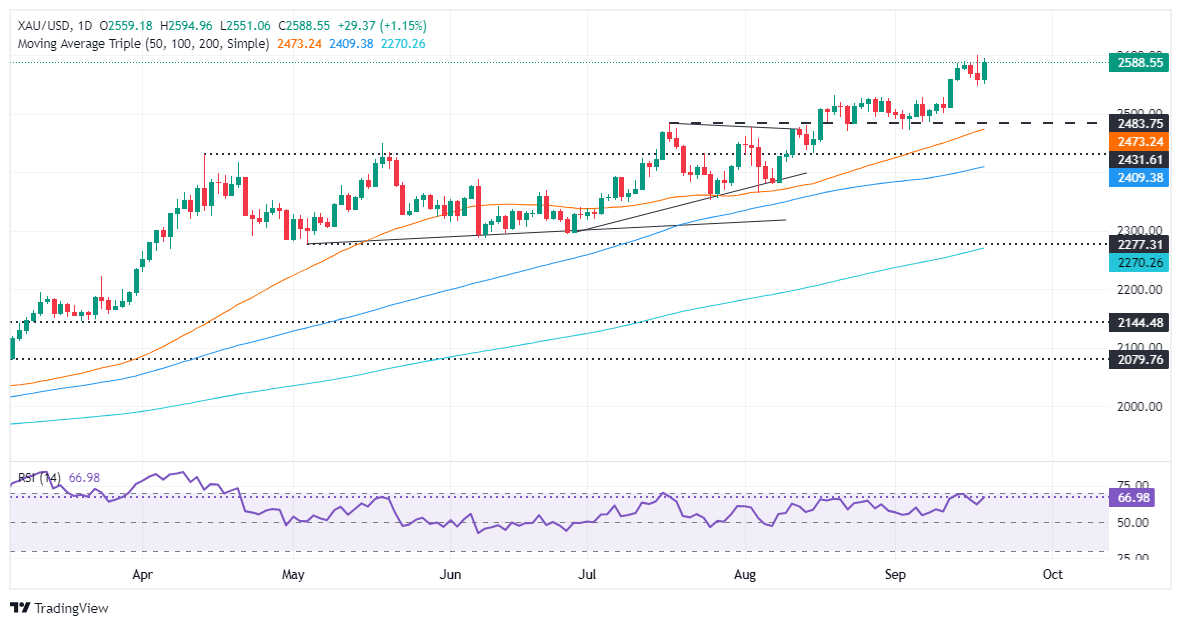Gold rises as Fed rate cut fuels bullish optimism toward $2,600

- Gold prices surge following the Fed’s 50 bps rate cut, with officials citing inflation moving toward the 2% target.
- Fed Chair Powell signals labor market strength and cautious policy adjustments, stating no rush to normalize rates.
- US jobs data shows resilience, while rising US Treasury yields fail to support the Greenback, as the DXY drops 0.31% to 100.62.
Gold prices advanced on Thursday after the Federal Reserve (Fed) embarked on an easing cycle with a 50-basis-point (bps) rate cut. Traders ignored the rise of US Treasury yields, which correlate inversely to the non-yielding metal, which remains on its way toward reclaiming $2,600. At the time of writing, XAU/USD trades at $2,589, up over 1%.
Following the Fed’s decision, bullion prices extended their gains after registering losses on Wednesday. Officials side with the larger of two cuts expected by Wall Street, justifying their decision by pointing to inflation moving sustainably toward the Fed’s 2% goal. Fed Chair Jerome Powell stressed that the Fed could maintain labor strength with policy adjustments.
Powell commented that risks of inflation diminished, while the labor market had risen. Still he added that if inflation persists, “We can dial back policy more slowly,” while adding that according to the bank’s projections, it’s “not in a rush” to normalize policy.
In the meantime, the US jobs data is taking the spotlight after Powell’s speech at Jackson Hole, in which he shifted toward attaining the maximum employment mandate. On Thursday, the US Labor Department revealed that the number of people filing for unemployment benefits was below expectations, indicating strength in the labor market.
Meanwhile, US Treasury yields follow Gold’s footsteps, with the 10-year T-note yielding 3.74%, rising three and a half basis points. However, this has failed to underpin the Greenback, which, according to the US Dollar Index (DXY), dropped 0.31% to 100.62.
Ahead this week, Philadelphia Fed President Patrick Harker will cross the wires amid a scarce docket in the US.
Daily digest market movers: Gold price recovers amid betterstrong US jobs market data
- Fed Governor Michelle Bowman voted to lower rates by a quarter of a percentage point at the September FOMC meeting.
- The Summary of Economic Projections indicates the Fed projects interest rates to end at 4.4% in 2024 and 3.4% in 2025. Inflation, as measured by the Core Personal Consumption Expenditures Price Index, is estimated to reach its 2% target by 2026, with forecasts of 2.6% in 2024 and 2.2% in 2025.
- US economy will likely grow at a 2% pace in 2024, with the Unemployment Rate rising to 4.4% by the end of the year.
- US Initial Jobless Claims for the week ending September 14 dipped from 231K to 219K, below estimates of 230K.
- US Existing Home Sales plunged 2.5% MoM in August after dipping from 3.96 million to 3.86 million, declining for the fourth time in the year.
- December 2024 fed funds rate futures contracting suggests that the Fed might lower rates by at least 69 basis points, implying that in the following two meetings this year the market expects one 50 bps and one 25 bps rate.
XAU/USD technical outlook: Gold price buyers target $2,600 after Fed’s decision
Gold price uptrend remains intact, but after Wednesday’s Shooting Star candlestick pattern, buyers must challenge the year-to-date peak of $2,599 if they would like to stay hopeful of conquering the $2,600 mark.
Momentum favors buyers. The Relative Strength Index (RSI) aims upwards in bullish territory and not in overbought territory. Therefore, the path of least resistance is tilted to the upside.
XAU/USD’s first resistance would be $2,599, followed by $2,600. On further strength, buyers can challenge the psychological levels of $2,650 and $2,700.
If XAU/USD drops below the September 13 low of $2,556, the next support would be $2,550. Once cleared, the next stop would be the August 20 high, which turned into support at $2,531, before aiming toward the September 6 low of $2,485.
Economic Indicator
Fed Interest Rate Decision
The Federal Reserve (Fed) deliberates on monetary policy and makes a decision on interest rates at eight pre-scheduled meetings per year. It has two mandates: to keep inflation at 2%, and to maintain full employment. Its main tool for achieving this is by setting interest rates – both at which it lends to banks and banks lend to each other. If it decides to hike rates, the US Dollar (USD) tends to strengthen as it attracts more foreign capital inflows. If it cuts rates, it tends to weaken the USD as capital drains out to countries offering higher returns. If rates are left unchanged, attention turns to the tone of the Federal Open Market Committee (FOMC) statement, and whether it is hawkish (expectant of higher future interest rates), or dovish (expectant of lower future rates).
Last release: Wed Sep 18, 2024 18:00
Frequency: Irregular
Actual: 5%
Consensus: 5.25%
Previous: 5.5%
Source: Federal Reserve
